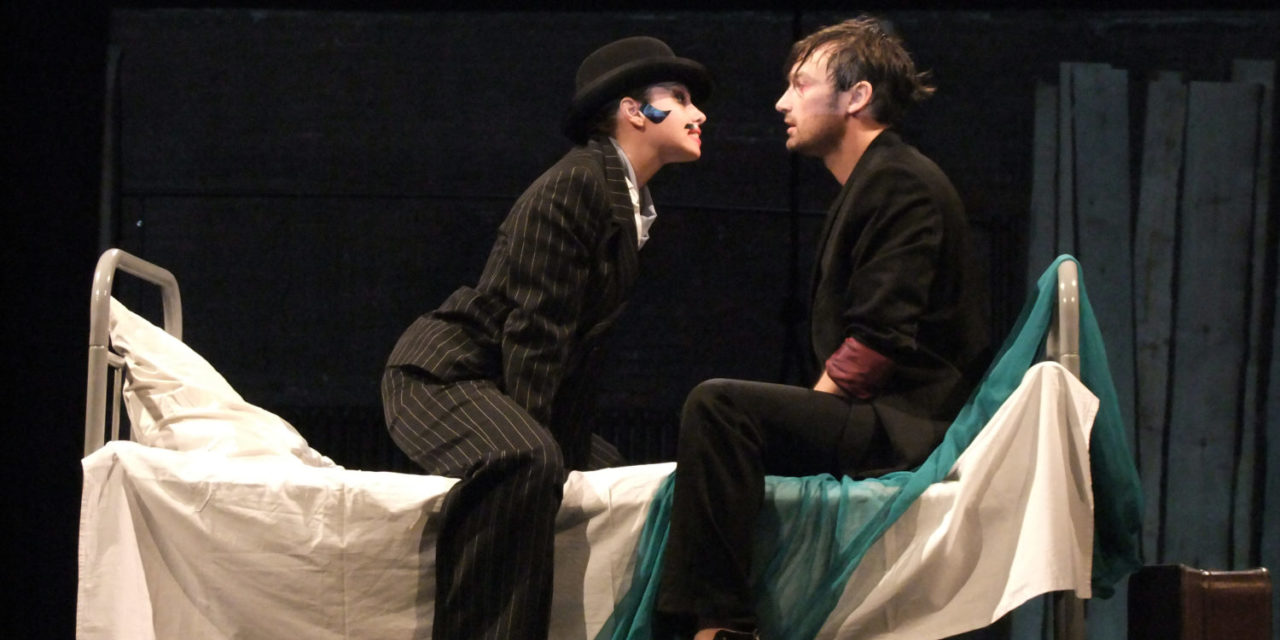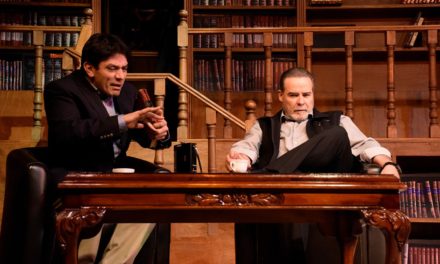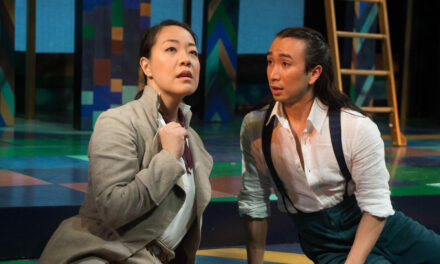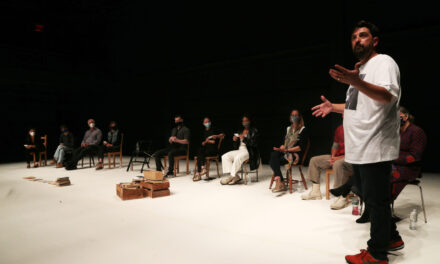It was long overdue for a British audience to be given the opportunity to see another work by the Russian theatre director Yury Butusov since his Measure For Measure (directed at the Vakhtangov Theatre) was performed at the Globe in 2012. Butusov’s bold and vigorous reinterpretations of classics (such as Waiting For Godot [1996], The Caretaker [1997], Richard III [2007], The Seagull [2011], Three Sisters [2015], Uncle Vanya [2018]) have won many accolades, including several Golden Mask awards. Butusov’s Meyerhold-influenced, contemporary approach to the European theatre canon reawakens these plays through his trademark dynamic, distinctively physical and visual interpretation.
His 2014 production with the Moscow Pushkin Drama Theatre, The Good Person Of Szechwan, was shown in London’s Barbican this February as part of the company’s larger-scale tour bringing three productions to the UK. Butusov’s energetic, unapologetic, modern-dress take on Brecht’s moral parable makes the performance relevant and timely. It is bursting with theatricality and exerts a powerful grip on the audience.
The staging expands on the elements of popular theatre in Brecht’s work: Butusov incorporates eclectic (although thematically related) elements of popular culture into the performance. The directing also centers around the strong acting and physicality of a highly skilled ensemble of actors. The result is a performance that not only enables the viewer to reconnect with Brecht’s play in a new way but also offers an exhilarating experience: that of being absorbed into an irresistible, idiosyncratic, dream-like world created on the stage and sustained over the show’s three-and-a-half hours.
Butusov’s approach to Brecht is fearless: he breaks with the tradition of pretending that the so-called V-effects (estrangement or distancing effects) in the play still function the same way as at the time of its writing (1938–41). It’s not only the distancing that Butusov removes, but anything else that became a convention standing between the audience experiencing the work as if it was for the first time, thus revealing its inherent theatricality.
Although microphone stands are lined up downstage for the songs, their performance no longer breaks up the flow of the drama. Instead, Butusov makes live music part of the continuous fabric of the production. Paul Dessau’s music is inventively refreshed and arranged (not without humor and irony) by Igor Gorsky, and is extended with an eclectic mix of jazz, blues, and even film music. The music is played on the stage by Gorsky’s ensemble, Chista Muzika (Pure Music). (It is a shame that the musicians and the other composers of the quoted music were not credited in the program.) The songs are sung in German, which make them acoustically harsher, rawer, and more expressive.

Moscow Pushkin Drama Theatre, The Good Person Of Szechwan; Alexandra Ursuliak. Image credit: Alex Yocu
Brecht’s text is cut substantially: its epic, narrative features are removed (long introductions or explanations); the scenes (especially the ones with the Gods) are condensed to their essential lines; unnecessary characters are removed, thus creating more tension and releasing the raw, “straightforward” drama of the story.
This has several consequences. First of all, it changes the audience’s relationship with the stage: instead of distancing, the show is now absorbing. Also, because of the cuts, the rhythm of the play changes: it becomes faster-paced and more energetic.
Treating the play as a “straightforward” drama, focusing on the human story rather than on the play’s other social attributes, exposes some of the melodramatic aspects of the love story in Brecht’s drama–perhaps this is also responsible for the fact that in the second half of the performance there are times when its energy drops a little, but usually the next song helps overcome that.
Yet, this “un-Brechtian” treatment of Brecht’s drama not only brings the play closer to a contemporary audience but also emphasizes the modern political relevance of Brecht’s work without sounding didactic.
Butusov’s interpretation subtly plays with the gendered question of agency and potency, and how it is also intertwined with power. (From this point of view, it is somewhat ironic that Brecht’s female co-authors of the play, Ruth Berlau, and Margarete Steffin, were left out of the show’s program notes.) The efforts of the protagonist, Shen Te, to be a good, moral person also get a very subtle feminist overtone: her failure to be good for others and for herself is not without relevance to her gender. The twisted-twin aspects of the “double life” of Shen Te are emphasized visually, most notably by the projection of Diane Arbus’s iconic 1967 photo Identical Twins.
The designers (set by Alexander Shishkin, lighting by Alexander Sivaev) opened up the Barbican’s stage to the back walls, emphasizing a vast, alien place, devoid of connections and warmth. A grove of bare trees, black bicycles, a stuffed stray dog, a doorframe with a door, a heap of white sacks (of tobacco) represent the struggling province of Szechwan, and its “poverty, debasement, and degradation.” Time after time images (a picture of a Madonna, photos of Chinese soldiers, etc.) are projected on the back wall. A monochrome palette dominates the set and the costumes, which gives a meaningful emphasis to colors when they appear (a red dress, a green scarf). In blessed moments the sky opens, and water, rice, or even packages of tobacco shower the people underneath.
The performance balances a clown-like, profane and humorous theatricality with a symbolic, almost dream-like visionary quality. Butusov skilfully weaves together the various elements of the performance into a powerful compound, whereby every detail has a symbolic, potent meaning beyond itself, and the totality of the whole has an immediate emotional grip on the audience.
For instance, in the opening scene of the play, the actor, who will later transform himself into the character of Wong, the water-seller, performs a ritual by laying down crisp, white bedsheets on the ground, and slowly pouring sand on them, from over his shoulder from metal buckets. Later, these sheets with the heavy sand in them are wrapped up and become the Gods’ luggage, the bundle that Shen Te has to carry into the house after her heavenly guests. The prostitute is balancing precariously on her killer heels, clearly struggling under the weight of the bundle, which begins to open in places, and its content starts escaping from it. This potent image summarises in one picture the main dilemma of the play: the human struggle with a moral obligation that is much bigger and harder to comply with in our society, and the foreboding that our inherent failure is included in the enormity of the command to be good.

Moscow Pushkin Drama Theatre, The Good Person Of Szechwan; Alexandra Ursulyak. Image credit: Alex Yocu
As a director, Butusov gives special attention to the (as he calls it) “plasticity of movement”: precisely developed physicality that reveals the personality of every character. (This approach to movement links him to the aesthetics of Pina Bausch, whose influence on his work Butusov acknowledges.) For instance, the predator-landlady, Mrs. Mi Tzu (Irina Petrova), who in her tight red dress stands out from the monochrome costumes, approaches her “prey” with small side steps, whilst bursting with aggressive sexuality.
Wong, the water-seller (Alexander Matrosov), is portrayed as a man with Down syndrome (a somewhat problematic directorial choice), who, being a Fool, has a special gift of having a connection with the Spiritual.
The three Gods are combined into one fragile, mainly silent character (played by Anastasia Lebedeva). She is angel-like and mighty in unworldly matters, yet fragile, and vulnerable in human conditions. With each appearance, she looks more and more broken and worn by her interaction with the human world. (First, she arrives with blistered feet from the journey; later she is rescued with a bloody bandage on her head; finally she appears to be heavily pregnant–mirroring Shen Te.) In the absence of the Gods’ voice, the character’s slow movements gain emphasis, sitting on a cobblestone, in a large black overcoat, which seems like a broken wing, wearing black boots on her bare legs–in her fragility, she resembles one of Paul Klee’s angel drawings.
The quality of acting of the ensemble is superb: like an orchestra, they are finely tuned to each other, dancing, singing, performing with such playfulness and ease that is a joy to watch. Yet, the star of the show is Alexandra Ursulyak, playing the double characters: the prostitute cum good person Shen Te and her invented cousin, Shui Ta, completely transforming herself into these two people. The physicality, the energy, and the potency of her acting are beyond compare. The subtlety with which she expresses the woman pretending to be a man is done with exceptional bravado. For instance, during a conversation with her former lover as a man, in her excitement, her unconscious gestures almost reveal her disguise. (For her performance Ursulyak received a Best Actress Golden Mask Award.)
In the final, courtroom scene of the performance, Arbus’s Identical Twins reappears on the black wall, gently swinging throughout Shen Te’s confession. Its rhythm is repeated by a swaying rail of grey dresses across the stage, serving as the thick curtains of the courtroom. Center stage the actor playing the Gods is sitting motionless, only holding the hand of Wong, the water-seller. Under their feet are hundreds of smashed cigarette packages from Shui Ta’s successful tobacco factory, while downstage right, into a microphone Shen Te makes her confession, revealing to them the reason behind her choice to live a double life.

Moscow Pushkin Drama Theatre, The Good Person Of Szechwan; Alexander Arsentiev, Anastasia Lebedeva. Image credit: Alex Yocu
Her appearance is clown-like, Chaplin-esque, and androgynous: heavily smudged smoky eyes, thick red lipstick, and a black mustache and sideburns. She is wearing a baggy black overcoat, bulky trousers with braces, and a large shirt covering her advanced state of pregnancy.
The monologue is sung as a gripping rap song: it is bursting with bitter desperation, accusation, and despair. While she is singing, she rips away her costume. Then she slowly removes her false mustache, and repeats the song in German, shouting it into the microphone in a croaky voice with a mighty force as if battling with the Gods above. As she sings, she lets her trousers fall down, revealing her legs in torn fishnet tights. At the end of the song, admitting her defeat, she turns away with a bent back. She looks forsaken, fragile and disillusioned. The Epilogue is cut from the play, the play ends on Shen Te’s words to the departing gods: ‘Help!’
Director’s theatre in Europe is undergoing a renewal: its practitioners in the forefront are combining the traditions of the profession with the innovations of performance-making and new dramaturgy. The result is a wonderful synthesis: innovative reinterpretations of the classics, 21st-century staging not devoid of postmodern irony and new media technology, combined with its traditionally characteristic strength of acting brought to the fore.
Last autumn Yury Butusov was appointed the chief director of the Vakhtangov Theatre. His first production under this title will be Ibsen’s Peer Gynt, opening in September. I hope this time a British audience won’t have to wait seven years to see Butusov’s ground-breaking work.
This post was written by the author in their personal capacity.The opinions expressed in this article are the author’s own and do not reflect the view of The Theatre Times, their staff or collaborators.
This post was written by Katalin Trencsényi.
The views expressed here belong to the author and do not necessarily reflect our views and opinions.


















